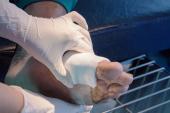SCAI-Led Position Statement on CLTI Spotlights Multispeciality Involvement
By collaborating in team-based care, specialties can improve training and ongoing education efforts, the document stresses.

Treating patients with chronic limb-threatening ischemia (CLTI) involves clinicians from many different medical fields. A new position statement from the Society for Cardiovascular Angiography and Interventions (SCAI), however, is calling for them to get on the same page with regard to expected clinical skills and competencies.
“This was a multidisciplinary effort where specialists that haven't traditionally always worked together, collaboratively, came together with a common unified interest,” the document’s writing chair, Beau M. Hawkins, MD (University of Oklahoma Health Sciences Center, Oklahoma City), told TCTMD.
The SCAI-led statement was endorsed by the American College of Radiology, American Podiatric Medical Association, Society for Interventional Radiology, Society for Vascular Medicine, Society for Vascular Surgery, Society for Clinical Vascular Surgery, and Vascular and Endovascular Surgical Society.
Published April 25, 2022, in the Journal of the Society for Cardiovascular Angiography & Interventions, the paper outlines six core competencies considered essential:
- Medical knowledge
- Patient care and procedural skills
- Systems-based practice
- Practice-based learning and improvement
- Professionalism
- Interpersonal and communication skills
Acknowledging that there is a range of complexity across the CLTI-specific competencies, it gives examples for each skill set that are stratified into “fundamental” and “advanced.” Within the medical knowledge category, a fundamental expectation in the medical therapy skill set is to know basic drugs for PAD, for instance, while the advanced expectation is familiarity with emerging medical therapies that have limb efficacy, such as PCSK9 inhibitors and direct oral anticoagulants.
Hawkins sees the document as a framework for ongoing collaborative efforts to ensure that everyone involved in the treatment of CLTI can work on tailoring professional education and outreach in their individual specialties to stay in line with the recommended core competencies. For example, existing training programs might use the recommendations to modify their curricula, possibly folding in additional rotations as needed to broaden trainees’ clinical experiences and patient interactions.
Lifelong Learning and Future Targets
Another major theme of the document is the importance of lifelong learning about CLTI regardless of specialty.
“I can envision where it would be possible to create some workshops or symposia that specifically target several of these competencies that have been outlined in the document,” Hawkins said. “Dedicated, enhanced training and education on CLTI care would be useful and very feasible to do.” On a multidisciplinary level, some of the individual groups that endorsed the document could pair up for training courses or seminars that incorporate a shared education experience, he said.
It was important that the document not exclusively focus on revascularization, Hawkins added, stressing the crucial role that multiple therapies play in the care of CLTI patients, who are typically comorbid and often frail. An underappreciation of PAD and how to manage it is a primary driver behind many of the recommended competencies. For endovascular specialists, the document advises that they “should acknowledge clinical scenarios in which patient care would be improved with referral to a more-advanced center or to a provider capable of providing further technical expertise.” Importantly, it also stresses viewing multidisciplinary care within CLTI “as a continuum” that should lead to collaborative treatment algorithms.
Looking to the future, the position statement notes that a key multispecialty priority will be the accumulation of better evidence to strengthen endovascular competency expectations.
“For example, training programs could have their trainees log CLTI procedures, stratified by segment and complexity, and submit these data to a central repository to accurately quantify the number and types of procedures that endovascular trainees are performing in CLTI patients during their training programs,” the document states. “Similar processes, though not specific to CLTI, already exist for some procedural specialties. One could envision such an endeavor being a collaborative effort amongst medical organizations who support the educational endeavors of endovascular specialists.”
Much like the heart team concept, Hawkins and colleagues say CLTI care may benefit from a team-centric model.
“Wide variation exists at an individual and institutional level regarding team components and the services rendered by individuals within the care team,” they write. “Institutions training residents, fellows, or practicing physicians to specialize in CLTI may use this competency-based framework to develop comprehensive programs fulfilling these educational needs. Ultimately, while immature at present, a CLTI certification process may be helpful to objectively appraise individual and institutional performance.”
Hawkins said he hopes the position statement is the first step in targeting gaps in care and bringing together the CLTI community to improve outcomes.
L.A. McKeown is a Senior Medical Journalist for TCTMD, the Section Editor of CV Team Forum, and Senior Medical…
Read Full BioSources
Hawkins BM, Li J, Wilkins LR, et al. Competencies for endovascular specialists providing CLTI care. JSCAI. 2022;Epub ahead of print.
Disclosures
- Hawkins reports no relevant conflicts of interest.





Comments